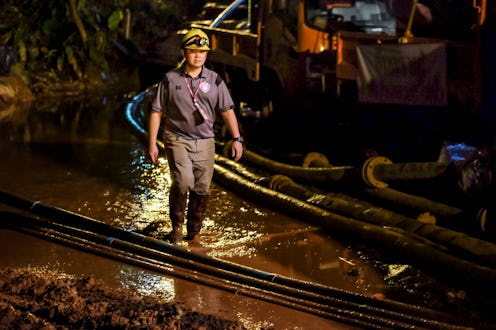News
This Map Of The Thai Cave Reveals Just What Rescuers Are Up Against

Several of the 12 young soccer players and their coach who have been trapped in a cave in Thailand for more than two weeks were finally rescued on Sunday, CNN reported. But with still more people left, there isn't much time for celebration, especially considering the danger each rescue attempt poses to both the divers and the boys. This map of the Thai cave shows why it's taken rescuers so long to extract the boys.
The rescue attempt began at 10 a.m. local time, and took about nine hours. (The full trip to the boys and back was previously thought to take about 11 hours, but efforts to drain some of the floodwater from the caves successfully made portions of it easier to navigate.) It required the expertise of 13 cave diving experts from around the world as well as five Thai navy seals, according to CNN. Local media have reported that as many as six boys have been rescued, though those reports are unconfirmed, according to the BBC. Rescue efforts are on pause to allow oxygen levels in the case to rise, and they will resume on Monday, the BBC reported.
The journey to rescue the boys and their coach is dangerous for a number of reasons — and all of them are captured in the below maps. First, the journey is a long one. It's almost three miles from the entrance of the cave to where the soccer team is located — about nine hours of travel, with portions of travel that are under water, CNN reported. Some of the boys reportedly can't swim well, leading some officials to think their journey out could take from two to four days, according to NBC News. The operation requires 90 dive experts total, according to the BBC.
Here's a rough step-by-step of the rescue expeditions:
- Teams of divers and other rescue teams are located at different points of the cave.
- A team of two divers has to escort each boy out one by one. According to the BBC, each boy is tethered to a diver, who is holding the boy's oxygen tank while also wearing their own oxygen tank. A second diver is then following behind the pair. Both divers are using lines of rope that were previously placed along the route.
- The majority of the cave is flooded, and parts of it are incredibly deep. One part, called T-junction, is so narrow that the divers have to take their oxygen tanks off of their backs and hold them in front of them to get through, according to CNN. The pass is one of the most difficult and dangerous.
- Once the divers reach their operating base (called Chamber 3, BBC reported) with the boys, they hand them off to other "specialist rescue teams" who then help them get through the rest of the cave, where the water is shallow enough to walk through, CNN reported.
The 12 boys are all between 11 and 16 years old, and they entered the cave on June 23 with their 25-year-old coach. They became trapped after monsoon rains led to flooding, NBC reported. They reportedly stayed alive for nine days by licking the walls of the cave for water until British divers discovered them.
Chiang Rai Gov. Narongsak Osottanakorn, the head of the rescue mission, described the first rescue attempt Sunday as "D-Day," according to NBC News. And his description isn't at all melodramatic. Rescuers are now racing the "torrential rain" of the next few days, the Daily Express reported, which could flood the cave so much that the boys could be trapped for another four months.
Complicating matters even further is the fact that divers and doctors are expected to make quick judgement calls regarding who gets to leave the cave first: "Divers will work with doctors in the cave to examine each the kids' health to determine who should get to come out first," Gov. Narongsak, according to NBC News.
Divers also face high risks: On Friday, the BBC reported that Petty Officer Saman Gunan ran out of oxygen and died on his way out of the caves after he delivered supplemental oxygen tanks. His team members told the BBC they "will not let the sacrifice of our friend go to waste."
Until the rescue efforts resume, social media is rallying around the boys and their coach in hopes that they can all be reunited with their families.